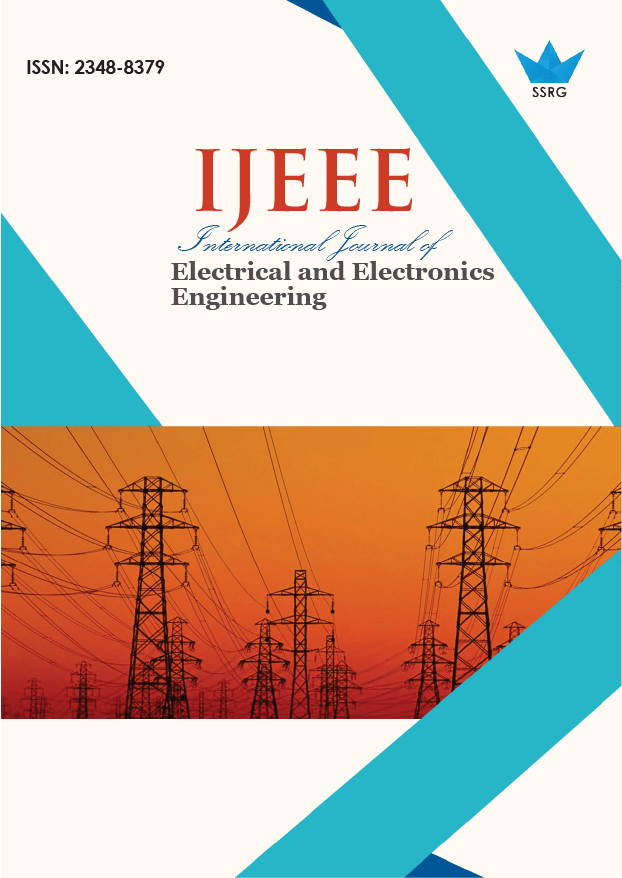Harnessing Artificial Intelligence for Improved Harmonic Reduction in Rectifier Systems: A Hybrid Power Filter Approach

| International Journal of Electrical and Electronics Engineering |
| © 2025 by SSRG - IJEEE Journal |
| Volume 12 Issue 8 |
| Year of Publication : 2025 |
| Authors : S. Parthasarathy, M. Ulagammai |
How to Cite?
S. Parthasarathy, M. Ulagammai, "Harnessing Artificial Intelligence for Improved Harmonic Reduction in Rectifier Systems: A Hybrid Power Filter Approach," SSRG International Journal of Electrical and Electronics Engineering, vol. 12, no. 8, pp. 140-153, 2025. Crossref, https://doi.org/10.14445/23488379/IJEEE-V12I8P114
Abstract:
Power electronics-based electrical equipment is widely used across modern industrial sectors, offering advancements in energy conservation, efficiency, performance, and industrial needs. However, these devices-such as rectifiers, converters, inverters, Variable Frequency Drives (VFDs), Uninterruptible Power Supplies (UPS), furnaces, and other equipment-are categorized as non-linear loads, leading to waveform distortion in the electric power supply. This waveform distortion is a significant issue, causing Power Quality (PQ) problems in both power systems and local distribution networks. Total Harmonic Distortion (%THD) is a key metric for assessing the extent of harmonic pollution in an electrical system. The IEEE 519-2022 standard provides clear guidelines on voltage and current harmonic limits (%THDV and %THDI) based on system voltage levels. This study focuses on reducing harmonics produced by a three-phase rectifier through the implementation of a hybrid harmonic filter that integrates both passive and active components. To improve the effectiveness of the active filter, an Artificial Neural Network (ANN) is employed. Real-time measured data are used to train the ANN, resulting in better %THDI reduction. The article presents a performance analysis of the proposed active harmonic filter, hybrid harmonic filter, and ANN-trained hybrid harmonic filter. Testing and validation of the proposed hybrid harmonic filters are conducted using the MATLAB simulation platform.
Keywords:
Artificial Neural Networks, Hybrid filters, Variable frequency drives, Total Harmonic Distortion, Harmonic filter.
References:
[1] P. Acharjee, and S.K. Goswami, “Expert Algorithm Based on Adaptive Particle Swarm Optimization for Power Flow Analysis,” Expert Systems with Applications, vol. 36, no. 3, pp. 5151-5156, 2009.
[CrossRef] [Google Scholar] [Publisher Link]
[2] Khaled Djerboub et al., “Particle Swarm Optimization Trained Artificial Neural Network to Control Shunt Active Power Filter Based on Multilevel Flying Capacitor Inverter,” European Journal of Electrical Engineering, vol. 22, no. 3, pp. 199-207, 2020.
[CrossRef] [Google Scholar] [Publisher Link]
[3] H. Akagi, “Modern Active Filters and Traditional Passive Filters,” Bulletin of the Polish Academy of Sciences: Technical Sciences, vol. 54, no. 3, pp. 255-269, 2006.
[Google Scholar] [Publisher Link]
[4] Alexander Kusko, Power Quality in Electrical Systems, McGraw-Hill Education, 2007.
[Google Scholar] [Publisher Link]
[5] Ali M. Eltamaly, “A Modified Harmonics Reduction Technique for a Three-Phase Controlled Converter,” IEEE Transactions on Industrial Electronics, vol. 55, no. 3, pp. 1190-1197, 2008.
[CrossRef] [Google Scholar] [Publisher Link]
[6] Ali M. Eltamaly, “A Novel Harmonic Reduction Technique for Controlled Converter by Third Harmonic Current Injection,” Electric Power Systems Research, vol. 91, pp. 104-112, 2012.
[CrossRef] [Google Scholar] [Publisher Link]
[7] Arindam Maitra, S. Mark Halpin, and Christopher A. Litton, “Application of Harmonic Limits at Wholesale Points of Delivery,” IEEE Transactions on Power Delivery, vol. 22, no. 1, pp. 263-269, 2007.
[CrossRef] [Google Scholar] [Publisher Link]
[8] Jos Arrillaga, and Neville R. Watson, Power System Harmonics, John Wiley & Sons, Ltd, 2003.
[CrossRef] [Google Scholar] [Publisher Link]
[9] A.Y. Hatata, M. Eladawy, and K. Shebl, “Parameter Control Scheme for Active Power Filter Based on NARX Neural Network,” WSEAS Transactions on Power Systems, vol. 13, pp. 118-124, 2018.
[Google Scholar] [Publisher Link]
[10] Barry W. Kennedy, Power Quality Primer, McGraw-Hill Education, 2000.
[Google Scholar] [Publisher Link]
[11] B. Singh, K. Al-Haddad, and A. Chandra, “A Review of Active Filters for Power Quality Improvement,” IEEE Transactions on Industrial Electronics, vol. 46, no. 5, pp. 960-971, 1999.
[CrossRef] [Google Scholar] [Publisher Link]
[12] F. Temurtas et al., “Harmonic Detection Using Feed Forward and Recurrent Neural Networks for Active Filters,” Electric Power Systems Research, vol. 72, no. 1, pp. 33-40, 2004.
[CrossRef] [Google Scholar] [Publisher Link]
[13] M.H.J. Bollen, “What is Power Quality?,” Electric Power Systems Research, vol. 66, no. 1, pp. 5-14, 2003.
[CrossRef] [Google Scholar] [Publisher Link]
[14] Chia-Nan Ko, Ying-Pin Chang, and Chia-Ju Wu, “A PSO Method with Nonlinear Time-Varying Evolution for Optimal Design of Harmonic Filters,” IEEE Transactions on Power Systems, vol. 24, no. 1, pp. 437-444, 2009.
[CrossRef] [Google Scholar] [Publisher Link]
[15] Chih-Ju Chou et al., “Optimal Planning of Large Passive-Harmonic Filters Set at High Voltage Level,” IEEE Transactions on Power Systems, vol. 15, no. 1, pp. 433-441, 2000.
[CrossRef] [Google Scholar] [Publisher Link]
[16] Swati Gade and Rahul Agrawal, “Optimal utilization of unified power quality conditioner using the JAYA optimization algorithm,” Engineering Optimization, vol. 55, no.1, pp. 1–18, 2023.
[CrossRef] [Google Scholar] [Publisher Link]

 10.14445/23488379/IJEEE-V12I8P114
10.14445/23488379/IJEEE-V12I8P114